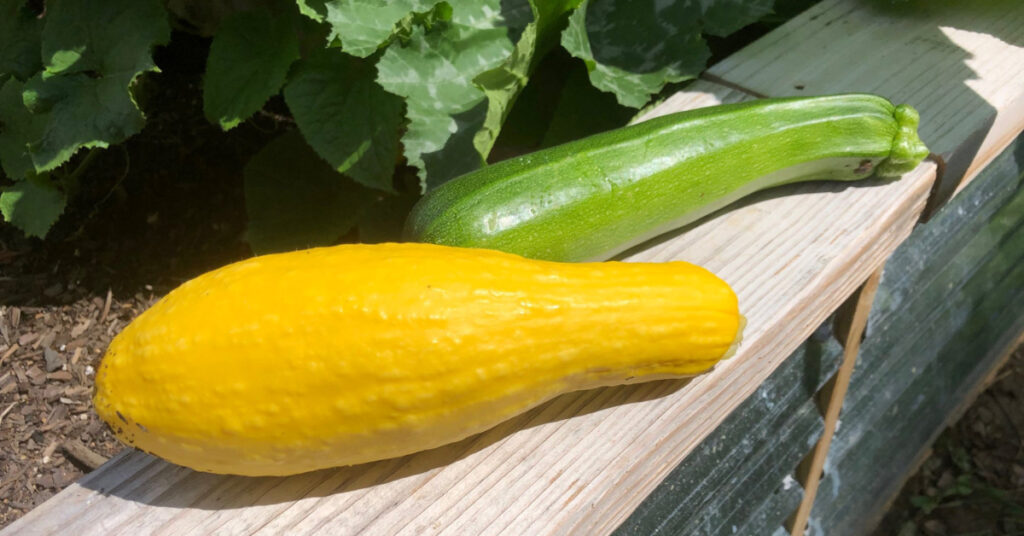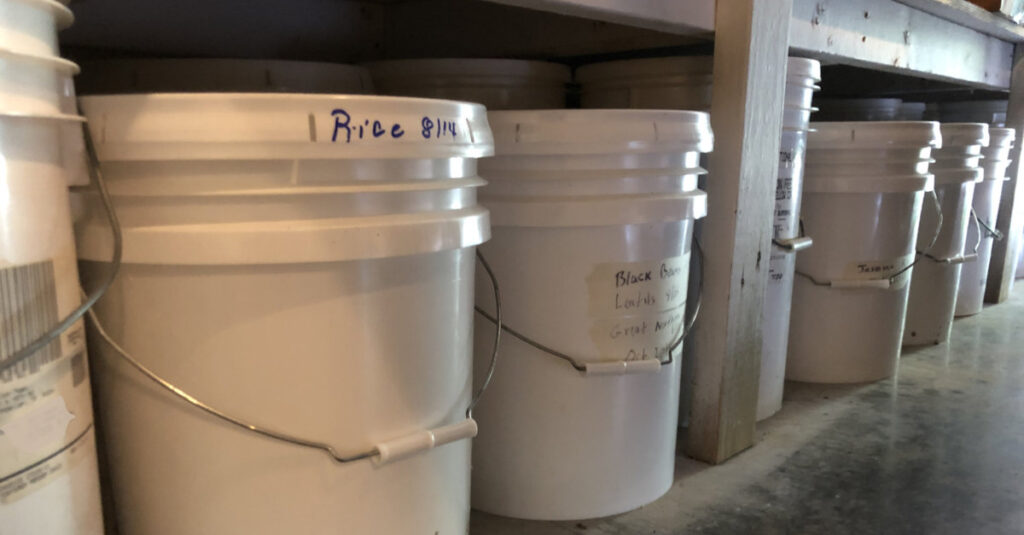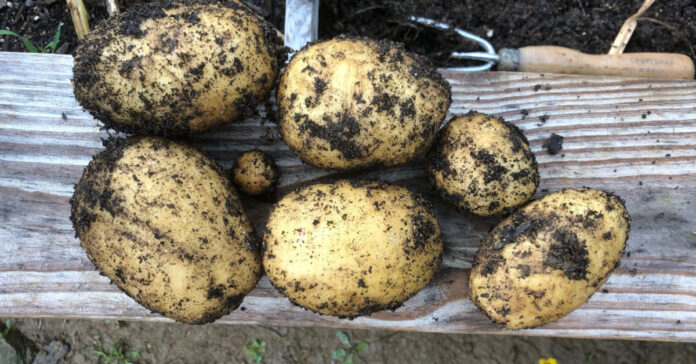As we enter August, most of the seeds and starts we planted in April, May and June are finally providing vegetables we can harvest. Our greens have been yielding results for some time, and we continue to nibble on a few cherry tomatoes, but this it is only in the past 10 days that we have been able to harvest more robust vegetables.
Potatoes
On April 4, I planted only five Yukon Gold seed potatoes and five German Butterball seed potatoes. I had not planned on planting potatoes, but a friend who did not use all their seed potatoes gave them to us.
We just harvested about 25 pounds of potatoes, less than I had hoped. The Yukon Gold outperformed the German Butterball in size and weight. In hindsight, I should have harvested the Yukon Gold and let the German Butterball stay in the ground for another two weeks. That would have allowed them to get larger. My wife, who is the gardening expert, says we probably needed more nitrogen. The means we will dress the bed with compost and chicken poop.
Next year, I may just stick with Yukon Gold potatoes. I am tempted to plant them a week or two earlier, but I am also hesitant to do so since it is still quite chilly in April. I will also do more mulching as we had a few potatoes with green sports on them where they grew above the soil level. These green spots develop when exposed to the sun and should not be eaten.
While harvesting potatoes, I was pleased to see that we had lots of earth worms. When you build raised beds, you have to hope the worms will find their way into the bed. I take their presence to be a good sign of our soil health.
Zucchini and Yellow Squash
I direct seeded both Zucchini and “Early Prolific Straight Neck” yellow summer squash on May 25. Both are doing quite well, despite the seed being four years old, and have yielded multiple fruits with more on the vine. When I came in the house yesterday morning with two more zucchinis, my wife said “I see zucchini bred in our near future.” I guess that means we’ve had more than we can eat in one sitting.
In another day or two, I will harvest another yellow squash, and that will give us enough for my wife to make squash casserole.
Next year, I will give the plants more room as I fear they are shading each other. I will also stagger plantings, planting some plants around the 15th and some four weeks later. That may give us some sooner and should spread out the harvest.

Cucumbers
I planted the cucumbers the same day as the squash, but they started slower and have not yet yielded any fruit. Maybe it has been too cool for the variety? I’d blame the squash for shading them, but they never grew as well from the get go. Also, despite being a bushy type, they are putting up runners and making use of the bamboo boles, so they are doing some climbing. I have not yet given up.
Next year, these may be worth planting inside in April and transplanting outdoors in mid to late May. That could give them the early start they need. I may also pick another variety.
Blackberries
I continue to harvest blackberries. Even though they are in their third week, there are still plenty of red berries still on the plants. Perhaps it is the heavy rains and lack of sun we’ve experienced. I am finding some berries that have turned gooey because of the frequent rains. Still, for plants that are wild and have never received an iota of attention from us, I can’t complain.
Chickens and Bees
The bees are still taking advantage of every sunny day to gather nectar, although the rain and high humidity makes it tough for them to convert it to honey. I plan to inspect the hives again either Wednesday or Thursday and swap our full frames or even add entire supers, if necessary.
The chickens are enjoying the bounty. My wife is weeding a couple times a day, and most of the weeds she pulls up go right into the chicken run. We have also been consuming local corn a couple nights a week, and the chickens get the left over cobs as well as any wormy pieces we cut out.
My Big Disappointment
So far, I have not seen a single sunflower, and I planted about 50 plants from three varieties in multiple locations. It’s enough to make me wonder if a family of clever chipmunks followed me around eating every seed.
As you may recall that I did not prepare any soil or plant these in a bed. Instead, I planted them along the driveway, in our meadow, along the edge of the garden fence, and in other random locations. I guess the weeds and wildflowers have choked them out.
All things considered, it would not surprise me if a few come up next year. I intend to plant more next year, but I’ll do so in a dedicated bed with some nice rich soil and plenty of compost. Good thing a 50-pound bag of Black Oil Sunflower seeds is pretty cheap.
My Biggest Lesson
The one thing I learned from our foray into gardening is that we have nowhere near enough flat land to plant enough food to come anywhere close to sustaining us. We are getting a few side dishes every week, but if there were eight or twelve people living here, our harvest would have given us each only a few bites. Even if I doubled our raised beds, we would barely make a dent in our food needs. This is where living on the side of a steep mountain with no pasture or fields is less than ideal for a sustenance farming standpoint.
It’s a darn good thing we have bees, chickens, apples, and wild game (I saw turkeys today), plus all our storage foods. The apples on all but one tree, by the way, are looking great. I am already feeding early ground apples to the chickens.
We will have to focus on fruit more than vegetables. Grain is certainly not an option. We don’t even have enough space for corn.
Next year, I’m going to plant blue berries. One of our neighbors raises them, and I am impressed by how many berries he gets from a single bush. Of course, it may take a few years until we get that level of harvest, but we already have the acidic soil they enjoy. I also think they will be better suited for our steep terrain. We seem to grow bushes and trees with no difficulty. I may look into raspberries, too, or take steps to encourage the few wild ones we have.
We have an elderly neighbor at the bottom of the mountain who has twelve flat acres (or what passes for flat around here) and used to have a large garden. If we were in a post-SHTF situation, we’d ask him if we could garden on his land in return for sharing the bounty with him.
I just wish someone in the area raised hogs.
Plan Accordingly
If I were approaching our homestead from the standpoint of needing to produce as many calories as possible to survive a crisis, I would double the number of beehives, raise more chickens, eat some of the chickens, and start raising rabbits. In our limited space, small livestock that can produce food frequently is the way to go.
Garden produce must be stored, which is easy with potatoes and cabbage, impossible with lettuce, and time consuming with products that must be pressure canned. Keeping food “on the hoof” eliminates storage. Honey has the added benefit of not needing to be canned or dehydrated. It stores indefinitely without any special treatment.
Consider this a reminder to keep stockpiling food. Build your prepper pantry and then add to your long-term storage food. The cans on your shelf and the buckets under it are guaranteed food. Your plan to garden is not a guarantee. (Even experienced gardeners have bad years.) Use our layered approach to prepping to ensure you have multiple foods stored in multiple ways, plus other sources such as a garden, livestock, and plans to hunt and gather.









